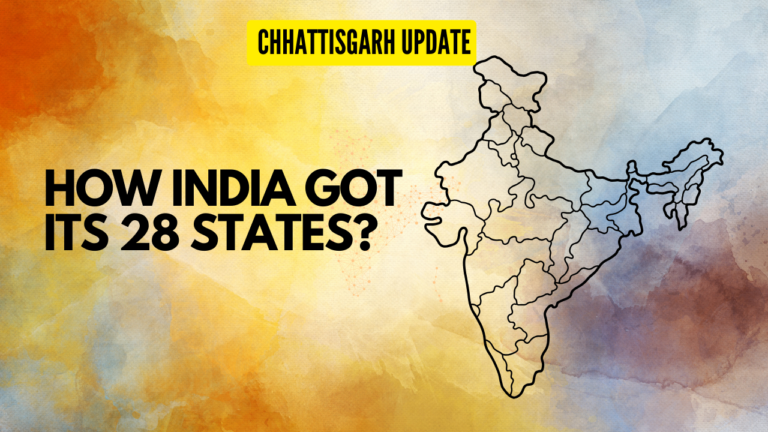Chhattisgarh, a captivating landlocked state nestled in Central India, has been silently but steadily emerging as a powerful player on India’s economic and cultural stage. With its vast expanse and a burgeoning population of approximately 30 million, Chhattisgarh stands as the ninth-largest state in India in terms of area and the seventeenth most populous. This article delves into the remarkable journey of Chhattisgarh, exploring its rich history, thriving economy, and unique geographical features.
Chhattisgarh, bordered by seven states, is strategically positioned at the heart of India. It shares its boundaries with Uttar Pradesh to the north, Madhya Pradesh to the northwest, Maharashtra to the southwest, Jharkhand to the northeast, Odisha to the east, and Telangana and Andhra Pradesh to the south. It was granted statehood on November 1, 2000, with Raipur as its designated capital, formerly being a part of Madhya Pradesh.
Chhattisgarh has carved a niche for itself as one of India’s fastest-developing states. Its Gross State Domestic Product (GSDP) in the year 2023-24 stands impressively at ₹5.09 lakh crore (US$64 billion), with a per capita GSDP of ₹152,348 (US$1,900) for the same period. This substantial economic growth can be attributed to its rich resource base, including the third-largest coal reserves in the nation, which significantly contributes to the supply of electricity, coal, and steel to other regions of India.
The state also boasts of an impressive natural asset, with over 40% of its land covered by lush forests, ranking third in forest cover after Madhya Pradesh and Arunachal Pradesh.
The etymology of the name “Chhattisgarh” is a subject of historical intrigue. Some theories suggest that it derives from the 36 ancient forts scattered across the region, with “Chhattis” meaning thirty-six and “garh” translating to fort. However, historical evidence to support this theory remains scarce. Others believe that the name originated from the Chedisgarh, signifying the “Empire of the Chedis,” harkening back to the Chedi dynasty of Kalinga in modern Odisha.
The roots of Chhattisgarh’s history run deep, with mentions in ancient texts like the Ramayana and Mahabharata. This region, once known as Dakshina Kosala, witnessed the dominance of various dynasties such as the Sharabhpurias, Panduvanshis, Somavanshi, Kalachuri, and Nagavanshi rulers between the sixth and twelfth centuries.
The Bastar region faced invasions by the Chola dynasty in the 11th century, leading to its eventual consolidation under the Haihaiyavanshi Kingdom, which ruled for nearly 700 years. However, in 1740, the Marathas invaded and took control of Chhattisgarh, marking a significant turning point in its history.
Chhattisgarh underwent a series of transitions, from Maratha Rule to British rule as the Chhattisgarh Division of the Central Provinces. Raipur’s prominence grew with the arrival of the British in 1845. Notably, in 1905, Sambalpur district was transferred to Odisha, and the Surguja estates shifted from Bengal to Chhattisgarh.
The state’s modern journey was further defined by its separation from Madhya Pradesh on November 1, 2000, after a prolonged demand for statehood. This move gave birth to the independent state of Chhattisgarh.
Chhattisgarh’s geography is as diverse as its history and economy. The state is characterized by hilly terrains in the northern and southern regions, while the central part boasts fertile plains. The Gaurlata peak near Samri in the Balrampur-Ramanujganj district is the highest point in the state.
The state’s rich forest cover, accounting for approximately 44% of its land, includes the Eastern Highlands Forests. In the north, the terrain transitions to the Indo-Gangetic plain, with the Rihand River draining this area. The eastern end of the Satpura Range and the western edge of the Chota Nagpur Plateau form an east–west belt of hills, separating the Mahanadi River basin from the Indo-Gangetic plain.
Natural Wealth
Chhattisgarh is endowed with an abundance of natural wealth, prominently including its thriving forests. It claims the title of having the third-largest forest cover in India, surrounded by states like Madhya Pradesh, Odisha, Maharashtra, Jharkhand, and Telangana, forming a vast expanse of greenery across state boundaries. This natural bounty supports multiple National Parks and Tiger Reserves, with the Achanakmar-Amarkantak Biosphere Reserve being a UNESCO-recognized gem in Chhattisgarh’s crown.
The state experiences a tropical climate with scorching summers, particularly due to its proximity to the Tropic of Cancer. Summer temperatures can soar up to 49°C (113°F), making the monsoon season, from late June to October, a welcome relief. Chhattisgarh receives an average annual rainfall of 1,292 millimeters (50.9 inches). Winters, occurring from November to January, bring pleasant weather, characterized by lower temperatures and reduced humidity.
Chhattisgarh’s connectivity is well-maintained, with an extensive network of four-lane and two-lane roads facilitating travel between major cities. The state is traversed by 20 national highways, encompassing a total length of 3,078 kilometers. Railways play a crucial role, with a rail network of 1,108 kilometers, ensuring efficient movement of goods and passengers.
Chhattisgarh is governed through a legislative assembly composed of 90 members. In terms of representation at the national level, it has 11 members in the Lok Sabha. The state also contributes five members to the Rajya Sabha.
Chhattisgarh, once a hidden gem, has emerged as a multifaceted state that blends rich history, thriving economy, and geographical diversity. Its journey from the past to the present is a testament to its resilience and potential, making it a rising star in the Indian landscape.



